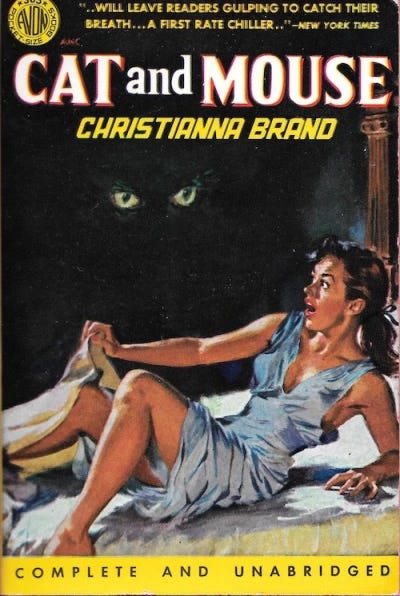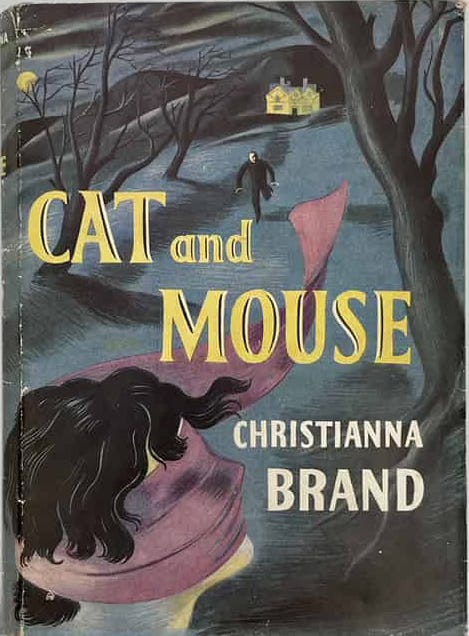Cat and Mouse by Christianna Brand
the country house mystery by way of charlotte armstrong and mary roberts rinehart (complimentary)
Mild spoilers throughout
We (thankfully) leave Lady Molly behind to explore feminine intuition of a different kind in Christianna Brand’s Cat and Mouse (1950). Often wrong and frequently foolish, Katinka (Tinka) Jones is still a vast improvement over Baroness Orczy’s annoyingly prescient detective. Tinka is an advice columnist known as Miss Friendly-wise at the perfectly named magazine Girls Together. Along with her colleague, Miss Let’s-be-Lovely, they answer reader questions about romance and beauty, respectively. One of their frequent letter writers, Amista, piques their curiosity, and when Tinka finds herself bored on a vacation visiting family in Wales, she decides to pay her a visit, as she lives nearby and has written extensively about the isolated home she shares with her guardian/lover, Carylon.
When Tinka arrives at the house, however, Carylon, who is just as Amista described him, insists that there is no one living there besides himself, his housekeeper and his man. Along with the unfortunately named Mr. Chucky, who has accompanied her to the house (accessible only by boat, usually ferried by the milk maid, Miss Evans), Tinka contrives to stay longer in order to investigate. Things take a turn so Gothic in nature that Jane Eyre is explicitly referenced more than once, as it is revealed that Mrs. Carylon, who may or may not be Amista, is indeed hidden away in the house.
I’m at risk of recapping the entire plot here. It is so delightfully, insanely, convoluted, with constantly shifting understandings between the characters and their motivations, that the temptation is to simply delve into its twists and turns like one of the novel’s gossipy townspeople.
Cat and Mouse is really a gothic thriller, with its scenic cliffs and Mr. Rochester-esque leading man, although there are elements of the classic country house mystery, particularly in the setting of an isolated house with its closed circle of suspects. Brand leans into the gothic melodrama in her descriptions of the landscape, but she also expertly lays out clues for the attentive reader, as in this scene where she seamlessly buries a major clue in a bit of business between Mr. Chucky and Tinka. They have gone up to the attic to snoop, finding trunks of clothes that they assume belong to Mrs. Carylon, who by this point is known to be tucked out of sight in the house, having been horribly disfigured in a car accident.
The little room was crowded with boxes and baskets and trunks and cases of every shape and size. Chucky went up to one, fiddled with the lock for a moment, and lifted the lid to reveal dresses, blouses, coats, skirts, evening frocks — out of date now, but still exquisite. He let the lid fall, and forced open another box of underclothes, silk and satin and lace. Another box: evening dresses. In the light of his torch, there was the sudden glitter of sequins on the soft glow of velvet. And another box and another… Shoes, hats, gloves, stockings, belts; filmy nightdresses, embroidered negligees, feathered satin mules… “Try a pair on,” said Chucky, tossing them familiarly over to Katinka. “You’re awful!” she said; but she could not resist slipping her bare feet into them and shuffling about the dusty attic floor. “Keep them,” said Chucky. “No one will ever know.”
She took them off quickly and put them back in their box. “You’re the most utterly unmoral person I ever met. I wouldn’t dream of keeping them.”
“You would if they weren’t miles too big,” said Chucky, laughing.
They are caught by Carylon’s man, and feint with that most hackneyed of moves: the fake kiss. To Tinka’s horror, Chucky claims they snuck upstairs for a “quick cuddle.” The focus of the scene is on Tinka’s discomfort and Chucky’s off-putting nosiness, so much so that the reader glosses over the cleverly-planted clue: the shoes, which presumably belong to the petite Mrs. Carylon, are too big for Katinka’s larger feet.
Tinka’s investigative methods involve her behaving in increasingly ridiculous ways, from pretending to be hurt to intentionally hurting herself in order to spend the night at the house, to turning back again and again when any sane person would run for the nearest milk boat and never return. She suspects every character of being guilty of something at one point or another, sometimes changing her mind and pointing fingers so fast she barely has time to catch her breath. She’s wrong about everything from start to finish, and yet she remains believable in Brand’s capable hands. She doubts herself frequently, wonders why she’s behaving the way she is (she’s got a crush on the devastatingly broody Carylon) and acts generally like a recognizable human being.
The first chapter, with Tinka still in London at the Girls Together offices is a tour-de-force of comedic tone-setting. Brand shows us the evolution from lonely good time girl Miss Katinka Jones of Girls Together (“She had grown, over the long years, very cool, very unsentimental, very insouciant. She was everlastingly gay.”) to the Tinka in the depths of her gothic nightmare: “The rain was an evil thing, a threat, it was like some danger know but not recognized that hung chokingly about the house, tapping at the doors and windows of her little cell of safety…”
Brand, who is perhaps best known today as the author of the Nurse Matilda books (made into the Nanny McPhee movies starring Emma Thompson), wrote widely across genres. Golden Age readers will know her best as the author of Green for Danger and Death of a Jezebel, among others, but it’s worth a detour into gothic melodrama for Cat and Mouse.
Further reading
If you prefer your mysteries sans melodrama, my favorite Brand novel is Green for Danger. I also strongly recommend the 1946 film of the same name, directed by Sidney Gilliat and starring Alastair Sim as Inspector Cockerel.
Read with me
I publish on Tuesdays, alternating between short stories and novels.
Next week: “The Hours of Darkness” by Edmund Crispin
In two weeks: The Benson Murder Case by S. S. Van Dine








